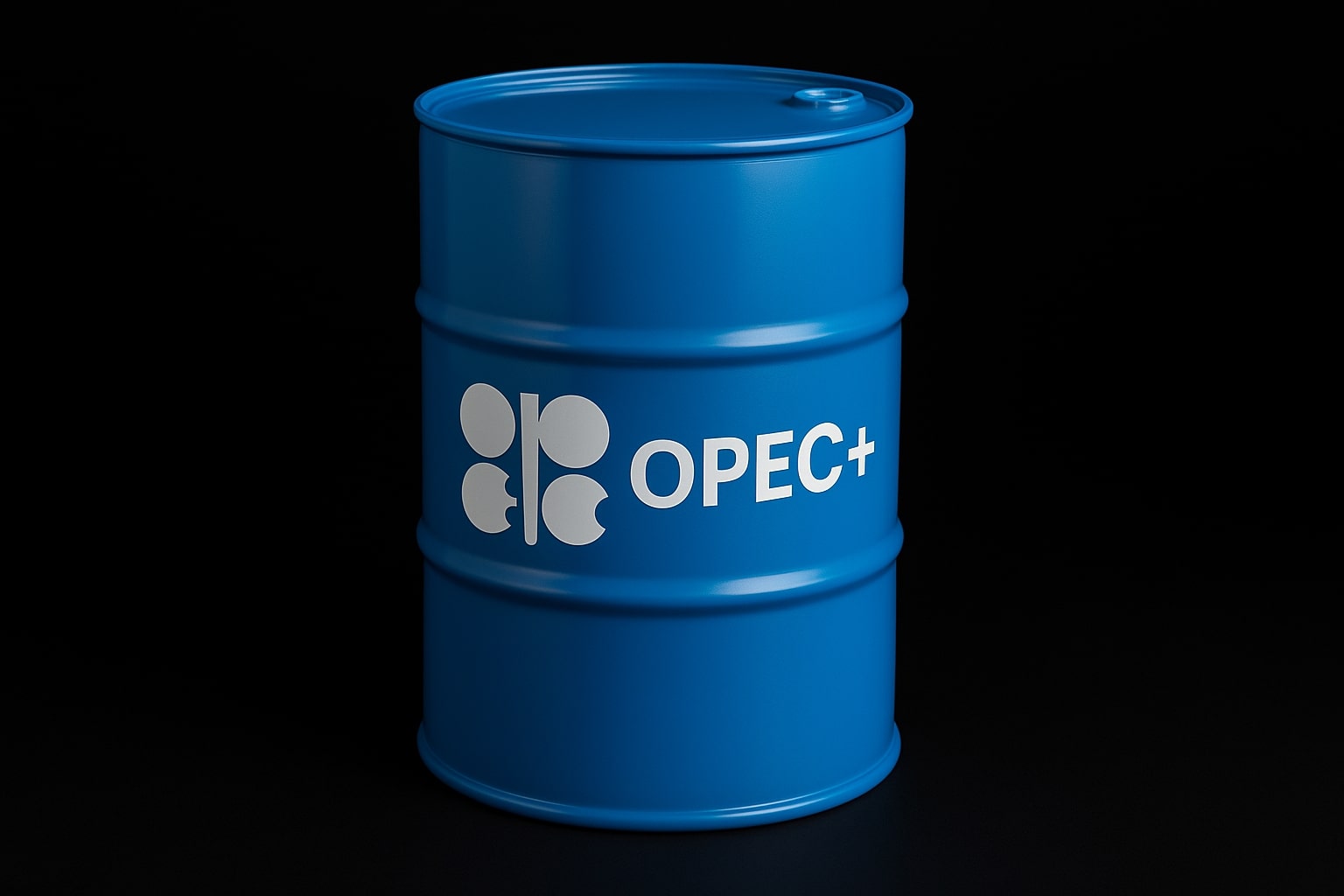
WTI Oil Price Dips to Four-Year Lows: What’s Behind the Slide and Can We Expect a Rebound?
As OPEC+ ramps up production, why have oil prices like WTI and Brent dropped sharply? Is this a temporary dip or the beginning of a larger market shift? | That's TradingNEWS
The Impact of OPEC+ Strategy on Global Oil Prices and U.S. Oil Stocks
The recent decision by OPEC+ to boost its production quota, raising output for June by an additional 411,000 barrels per day (bpd), marks the third consecutive month of output increases. This surge in production, alongside geopolitical tensions and shifting market dynamics, has rattled global oil prices and intensified fears of oversupply in the oil market. On Monday, the U.S. West Texas Intermediate (WTI) crude oil futures settled down 2.2% at $57.04 per barrel, marking a four-year low. Similarly, Brent crude dropped by 1.7% to $60.23 per barrel, signaling a broader decline that has affected oil producers and stock prices across the board.
OPEC+'s accelerated output expansion, totaling 960,000 bpd over three months, signals a robust market share competition as Saudi Arabia pushes to regain ground lost to non-OPEC producers like the U.S. While this decision might ease some market uncertainties, the OPEC+ production hikes have sparked fears of a supply glut, which has played a significant role in the price drop seen over the past few weeks.
The global oil market was already under strain due to President Trump's aggressive tariff policy, which directly contributed to the price slump. Oil prices have fallen over 10% over the last six sessions, exacerbating concerns of a prolonged downturn. These price adjustments—fueled by an increase in production coupled with a weakening demand outlook—pose significant risks to the stability of oil-related stocks. The broader impact can be seen in the movement of key U.S. oil stocks, including Chevron (CVX), Exxon Mobil (XOM), and Occidental Petroleum (OXY), which all saw declines in their market prices following OPEC+ decisions.
OPEC+'s Production Strategy and Its Market Implications
The decision to expedite production hikes is not solely an economic one but also has a geopolitical angle. Saudi Arabia's move to penalize non-compliant OPEC+ members such as Iraq and Kazakhstan, who have been producing above their agreed quotas, aligns with the broader strategy to curb the U.S. shale industry’s dominance. The U.S., which set a record oil production rate of 13.45 million bpd in October 2024, has seen production fluctuate but remains a key player in the global supply chain.
The production increase also comes amidst rising concerns over U.S. shale output reaching its peak, particularly in the Permian Basin, where the growth potential is beginning to stall. As companies like Diamondback Energy forecast a decline in U.S. onshore oil production, analysts predict that the Permian Basin's output could fall by up to 10% by the third quarter of 2025. In this scenario, the U.S. shale industry, which has been a major contributor to global oil supply growth, might find itself unable to keep up with the demand in the face of declining activity.
The Role of U.S. Shale Production in Global Oil Supply
Amid OPEC+ pushing to regain market share, the U.S. oil industry, particularly shale producers, is facing an uncertain future. Companies like Diamondback Energy have already started scaling back operations, with a 15% decline in fracking crews and further reductions expected in the coming months. This slowdown, as well as a decrease in U.S. oil-directed rig counts, suggests that U.S. oil production may have peaked. If these trends continue, it will put additional strain on the global supply chain, making OPEC+ decisions all the more critical for determining future oil price trends.
The impact of these production adjustments is already being felt. Diamondback Energy has lowered its investment in the Permian Basin by 30% for the second half of 2025. Meanwhile, Coterra Energy, another major player in the shale industry, is following suit with similar cuts, signaling a broader industry trend of conservative production strategies in response to the volatile price environment.
Trump’s Tariff Policy and Its Effect on Oil Prices
U.S. President Donald Trump’s sudden tariff announcements in early April have had a direct impact on the oil market. By threatening further sanctions against countries purchasing oil from Iran, Trump has significantly disrupted the oil supply chain. This move, along with the broader geopolitical uncertainty, has contributed to the downward pressure on prices, as traders react to the possibility of a prolonged U.S.-Iranian standoff. The tightening of U.S. sanctions, coupled with OPEC+’s decision to ramp up production, has made it even more challenging for global oil prices to recover, further complicating the decision-making process for oil producers and investors alike.
The U.S.'s focus on the Middle East is likely to continue to shape oil prices in the coming months, with Iran’s exclusion from the global oil market potentially creating a void that Saudi Arabia and Russia may look to fill. The combination of these geopolitical shifts and economic sanctions leaves the global oil market in a state of flux, adding volatility to the outlook for both producers and consumers.
The Outlook for Oil Prices and the Global Economy
With global demand for oil slowing, particularly due to tariff tensions between the U.S. and China, analysts predict that oil prices will struggle to maintain upward momentum. The latest forecast adjustments by major institutions like Barclays and Goldman Sachs have downgraded their 2025 and 2026 price predictions, citing the oversupply concerns and the economic slowdown stemming from the ongoing tariff conflicts.
Barclays has reduced its Brent crude forecast for 2025 by $4, setting it at $66 per barrel, while ING revised its 2025 estimate to $65. These downgrades reflect growing concerns about the potential for a global recession and the likelihood that oil supply will outpace demand in the coming months. Additionally, U.S. energy consultancy Ritterbusch and Associates warns that mounting global inventories could push oil prices even lower in the near term.
The market's bearish sentiment is further exacerbated by the uncertainty surrounding OPEC+'s production strategy, which, while designed to address non-compliant members and regain market share, has also contributed to a swelling of global oil inventories. If these inventories continue to rise while demand remains weak, oil prices could see a more sustained decline, creating challenges for oil producers and stakeholders in the industry.
As oil prices hover around four-year lows, reaching their lowest levels since February 2021, investors and analysts are left to question whether this is a temporary setback or a more prolonged downturn. The upcoming meetings within OPEC+ and the evolving political landscape, particularly the tension between the U.S. and Iran, will likely play a decisive role in shaping the future of global oil markets.
What This Means for Oil Stocks
As OPEC+ continues its strategy of increasing production, oil-related stocks, particularly those of major players like Chevron (CVX), Exxon Mobil (XOM), and Occidental Petroleum (OXY), may continue to feel the pressure of declining oil prices. These stocks, which have already taken a hit in recent trading sessions, could face further volatility as market forces shift and production quotas evolve.
Additionally, oil tanker stocks such as Teekay Tankers (TNK) and International Seaways (INSW), which have been rallying in recent sessions, could see continued growth if demand for oil transportation remains strong despite falling crude prices.
The Broader Impact on the Global Oil Economy
The oil price landscape has entered a period of heightened volatility. With the added uncertainty of geopolitical tensions and fluctuating supply-demand dynamics, the global oil economy is in uncharted territory. As OPEC+ attempts to balance production increases with the evolving geopolitical environment, the outlook for oil prices remains uncertain. For now, the market will continue to monitor the actions of OPEC+ and the broader geopolitical developments, as they will likely shape the oil price trajectory in the months ahead.
That's TradingNEWS
Read More
-
BITQ ETF Soars 66.55% as Bitcoin Blasts Past $124,000 — Crypto Equities Lead 2025 Rally
13.10.2025 · TradingNEWS ArchiveStocks
-
XRP ETFs XRPR, XRPI Slip as Ripple XRP-USD Holds $2.62 — SEC Fast-Track Could Ignite $20B
13.10.2025 · TradingNEWS ArchiveCrypto
-
Natural Gas Price Forecast - NG=F Steadies at $3.00 as U.S. Export Boom Tests Old Fields
13.10.2025 · TradingNEWS ArchiveCommodities
-
USD/JPY Price Forecast - Dollar to Yen Climbs to ¥152.28 as Japan’s Political Shakeup
13.10.2025 · TradingNEWS ArchiveForex



















